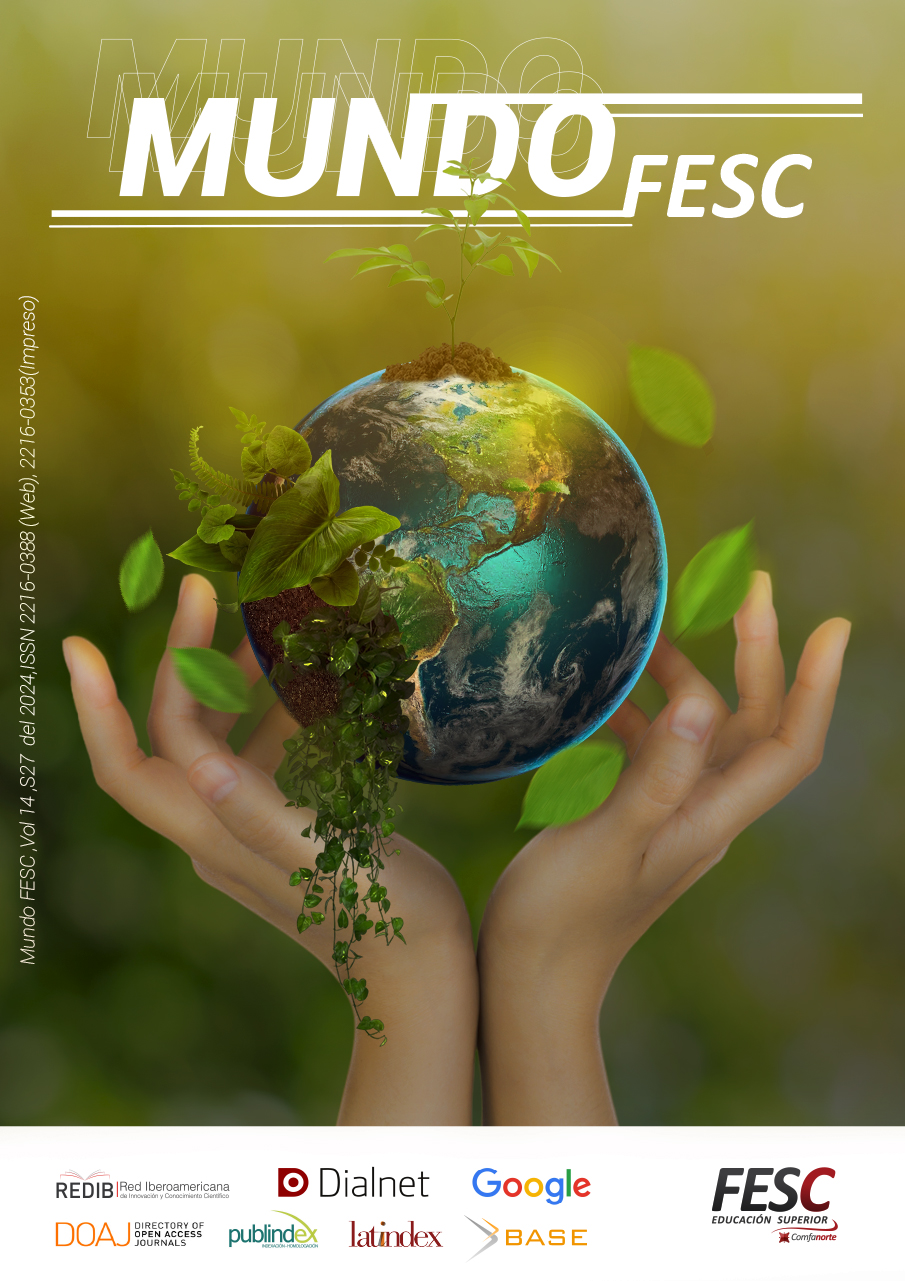Puertos conectados: La era de la inteligencia logística y medioambiental
DOI:
https://doi.org/10.61799/2216-0388.1756Palabras clave:
Industria 4.0, Logística, Medio Ambiente, Puertos Inteligentes, Transporte MarítimoResumen
Con el comienzo de la cuarta revolución industrial el mundo se ha enfrentado al surgimiento de nuevas tecnologías que han traído un impacto positivo en la vida cotidiana de las personas. La importancia y la necesidad de identificar las tendencias de investigación
relacionadas con los puertos inteligentes para fines académicos y operativos son el objetivo del presente trabajo. Para ello se implementó la metodología de la metáfora del árbol y, específicamente, el análisis de red en la definición de las temáticas más relevantes y las prácticas que los potencian y definen. Los resultados resaltan que los retos en la mejora de las operaciones logísticas en cada eslabón de la cadena de suministro han desarrollado nuevas dinámicas en el marco de la revolución 4.0. En este escenario, los puertos automatizados han emergido como una estrategia para atender las necesidades de los clientes a través de la implementación de avances tecnológicos.
Descargas
Referencias
[1] O. D. R. Sanchez, Indicadores de Productividad para la Industria Potuaria: Aplicación en América Latina y el Caribe. United Nations Publications, 2006. [Online]. Available: https://books.google.com/books/about/Indicadores_de_Productividad_para_la_Ind.html?hl=&id=LAEob-D03I4C
[2] L. V. Gálvez, Industria 4.0: gestión del conocimiento. Editorial Universidad Icesi, 2021. [Online]. Available: https://play.google.com/store/books/details?id=Kh_YzgEACAAJ
[3] N. Nomikos, P. K. Gkonis, P. S. Bithas, and P. Trakadas, “A Survey on UAV-Aided Maritime Communications: Deployment Considerations, Applications, and Future Challenges,” IEEE Open Journal of the Communications Society, vol. 4, pp. 56–78, 2023, doi: 10.1109/OJCOMS.2022.3225590. DOI: https://doi.org/10.1109/OJCOMS.2022.3225590
[4] P. Cartagena, “La cuarta oportunidad,” Pórtico, 2018.https://www.puertocartagena.com/sites/default/files/RevistaPortico2018-compressed.pdf (accessed Jul. 28, 2023).
[5] NexusAdmistraIntegra, “Puertos inteligentes: la transformación del sector portuario,” Nexus Integra, Apr. 22, 2022. https://nexusintegra.io/es/puertos-inteligentes-la-transformacion-sector-portuario/(accessed Jul. 28, 2023).
[6] “Vista de El impulso de la digitalización de los puertos del Sistema Portuario Español mediante el análisis
Business Observation Tool.”https://doi.org/10.14482/inde.38.2.650 (accessed Jul. 28,2023). DOI: https://doi.org/10.14482/inde.38.2.650
[7] CEPAL, “Digitalización en puertos: aplicación de gemelos digitales en la complejidad logística,” 2022. [Online]. Available:https://books.google.com/books/about/Digitalizaci%C3%B3n_en_puertos_aplicaci%C3%B3n_d.html?hl=&id=
D5B9zwEACAAJ
[8] D. S. Valencia-Hernandez, S. Robledo, R. Pinilla, N. D. Duque-Méndez, and G. Olivar-Tost, “SAP algorithm for citation analysis: An improvement to tree of Science,”Ing. Investig., vol. 40, no. 1, Mar. 2020, doi:10.15446/ing.investig.v40n1.77718. DOI: https://doi.org/10.15446/ing.investig.v40n1.77718
[9] S. Robledo, M. Zuluaga, L.-A. Valencia-Hernandez, O.A.-E. Arbelaez-Echeverri, P. Duque, and J.-D. Alzate-Cardona, “Tree of Science with Scopus: A Shinyapplication,” Issu. Sci. Technol. Libr.., no. 100, Aug.2022, doi: 10.29173/istl2698. DOI: https://doi.org/10.29173/istl2698
[10] C.-H. Chiang, L.-B. Chen, S.-Y. Kuo, L.-J. Lin, Y.-P.Lin, and Y.-C. Hsu, “Evaluation of Supply Chain Management on Green Performance in Taichung Smart Port of Taiwan,” in 2022 IEEE 11th Global Conference on Consumer Electronics (GCCE), Oct. 2022, pp.549–550. doi:10.1109/GCCE56475.2022.10014316. DOI: https://doi.org/10.1109/GCCE56475.2022.10014316
[11] Y. Boullauazan, C. Sys, and T. Vanelslander, “Developing and demonstrating a maturity model for smart ports,” Marit. Policy Manage., pp. 1–19, May 2022, doi: 10.1080/03088839.2022.2074161. DOI: https://doi.org/10.1080/03088839.2022.2074161
[12] J. Chen, T. Huang, X. Xie, P. T.-W. Lee, and C. Hua,“Constructing Governance Framework of a Green and Smart Port,” J. Mar. Sci. Eng., vol. 7, no. 4, p. 83, Mar. 2019, doi: 10.3390/jmse7040083. DOI: https://doi.org/10.3390/jmse7040083
[13] A. Othman, S. El Gazzar, and M. Knez, “Investigating the Influences of Smart Port Practices and Technology Employment on Port Sustainable Performance: The Egypt Case,” Sustain. Sci. Pract. Policy, vol. 14, no. 21, p. 14014, Oct. 2022, doi: 10.3390/su142114014. DOI: https://doi.org/10.3390/su142114014
[14] “LOS PUERTOS INTELIGENTES: ELEMENTOS PARA UN DESARROLLO SOSTENIBLE,” in Luces en el camino: Filosofía y Ciencias Sociales en tiempos de desconcierto, 2021, p. 18. Accessed: Jul. 28, 2023. [Online]. Available: https://www.researchgate.net/publication/351109303
[15] A. E. Idrissi, A. Haidine, A. Aqqal, and A. Dahbi, “Deployment Strategies of Mobile Networks for Internet-of-Things in Smart Maritime Ports,” in 2022 11th International Symposium on Signal, Image, Video and Communications (ISIVC), May 2022, pp. 1–6. doi:10.1109/ISIVC54825.2022.9800728. DOI: https://doi.org/10.1109/ISIVC54825.2022.9800728
[16] C. Jahn and N. Nellen, “Smart Port Concept: Strategic Development, Best Practices, Perspectives of Development,” in Arctic Maritime Logistics: The Potentials and Challenges of the Northern Sea Route, I. Ilin, T. Devezas, and C. Jahn, Eds., Cham: Springer International Publishing, 2022, pp. 81–93. doi:10.1007/978-3-030-92291-7_5. DOI: https://doi.org/10.1007/978-3-030-92291-7_5
[17] “Manual de puertos inteligentes: Estrategia y hoja de ruta.”https://publications.iadb.org/publications/spanish/viewer/Manual-de-puertos-inteligentes-Estrategia-y-hoja-de-ruta.pdf (accessed Jul. 28, 2023).
[18] B. T. H. Yen, M.-J. Huang, H.-J. Lai, H.-H. Cho, and Y.-L. Huang, “How smart port design influences portefficiency – A DEA-Tobit approach,” Res. Transp. Bus.Manag., vol. 46, no. 100862, p. 100862, Jan. 2023, doi:10.1016/j.rtbm.2022.100862. DOI: https://doi.org/10.1016/j.rtbm.2022.100862
[19] H. P. Nguyen, N. D. K. Pham, and V. D. Bui,“Technical-Environmental Assessment of Energy Management Systems in Smart Ports,” International Journal of Renewable Energy Development, vol. 11, no.4, pp. 889–901, Nov. 2022, doi:-ciii@ibero.edu.co10.14710/ijred.2022.46300. DOI: https://doi.org/10.14710/ijred.2022.46300
[20] J. Xiao, “Ship dynamic positioning control based on nonlinear fuzzy algorithm for a smart port city,” J. Test. Eval., vol. 51, no. 3, p. 20220083, May 2023, doi: 10.1520/jte20220083. DOI: https://doi.org/10.1520/JTE20220083
[21] Y. Wang, W. Feng, J. Wang, and T. Q. S. Quek, “Hybrid Satellite-UAV-Terrestrial Networks for 6G Ubiquitous Coverage: A Maritime Communications Perspective,”IEEE J. Sel. Areas Commun., vol. 39, no. 11, pp.3475–3490, Nov. 2021, doi:10.1109/JSAC.2021.3088692. DOI: https://doi.org/10.1109/JSAC.2021.3088692
Descargas
Publicado
Número
Sección
Licencia
Derechos de autor 2025 Mundo FESC

Esta obra está bajo una licencia internacional Creative Commons Atribución-NoComercial 4.0.






